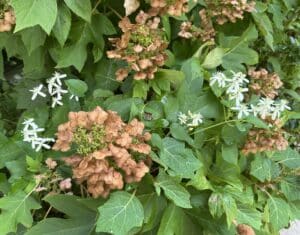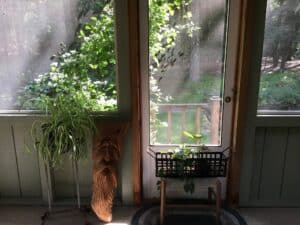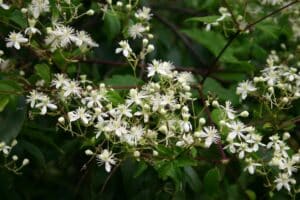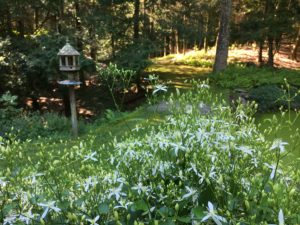Hello, fellow lovers of all things green,
I look forward to sharing an update on a long-ago story about a real softie, a soft-wooded Sweet Autumn Clematis, in its glory this time of year. With a plethora of tiny white blooms from August to September, she resembles a snowdrift and smells heavenly. I love the fragrance brought in by the cooler evening breeze as I snag the last of the summer season’s porch campouts on the futon. And adore waking to the busy hums of what I think are bumblebees with fuzzy yellow backs and black bodies, though they seem smaller than the common Eastern Bumble Bee (Bombus impatiens). But there is a downside to her invasive nature, though there are remedies to manage her ambition, plus a native alternative I just learned about!
Sweet Autumn Clematis is a real softie
Unlike Wisteria or Trumpet Vines, which folks start out loving until the strength of the woody climbers destroys their deck or pergola, Sweet Autumn Clematis’s soft, woody nature won’t harm rails or screens. Plus, she blooms on new wood, so you can easily manage her size without missing out on glorious blooms.
Once the flowers fade, a silvery blanket of seed heads follows, contrasting beautifully with the dark, almost blue-green leaves. I let this beauty scramble up the screened porch stairs and make its way onto the screens. It’s true; you may have to tiptoe around to exit from the porch to the outside, a path rarely taken, not because of the sweetie.
Clematis prefer sunny heads and cool feet.

Munchkin Oakleaf Hydrangea in her late-summer glory.
Hardy from zone 5 to 8 (some say 9), like other clematis, Clematis terniflora likes cool feet and sunny heads. That means cool roots and sunny foliage for those of you who don’t think of plants as having people-parts. I have one happy Sweet Autumn Clematis doing fine in afternoon shade, though she thrives in full sun.
Mulch generously or shade the roots with a companion plant, such as a low-growing hydrangea. Ruby Slippers Oakleaf Hydrangea, Hydrangea quercifolia, is a favorite that comes to mind. Indeed, they aren’t native here in NJ/ PA, but the straight species of Oakleaf Hydrangea is native in the southeastern United States, spanning from North Carolina and Tennessee south to the Florida Panhandle and west into Louisiana. So I am a fan of them. My ‘Munchkin’ Oakleaf Hydrangea has a Sweet Autumn Clematis poised on a trellis behind it next to the door Jolee and I come and go from. And there’s a tendril of the clematis peeking through the foliage and flowers that are now shifting to their fall, freckled in a lovely dusty pink.
Native shrubs I adore for cooling the feet of clematis in partially shaded areas include Lowbush blueberry (Vaccinium angustifolium), with edible berries and brilliant red foliage in the fall. There’s Dwarf bush honeysuckle (Diervilla lonicera) with yellow flowers that hummingbirds adore. And inkberry holly (Ilex glabra), I plant instead of boxwood to provide a lush, dark green backdrop for your clematis.

A view of Sweet Autumn Clematis looking out from my screened porch. What’s not to love?
How to Remedy Sweet Autumn Clematis’s Ambition
Sweet Autumn Clematis is considered invasive by many. She self-seeds readily in some areas. Not in my yard. Maybe because of its location, seeds drop in the lawn area, and therefore, any volunteers are cut down by the mower. However, recently, a client in Essex County has experienced an issue with volunteers overwhelming their beds. And Sweet Autumn Clematis has been seen running amok along highways.
A remedy in areas where Sweet Autumn Clematis can be maintained is to prune the clusters of seed heads before they dry and turn brown, thereby preventing self-seeding. Then, each year when dormant, cut her down to about a foot above ground to maintain her 20-foot scramble each year. I’ve even let her scramble as a ground cover with great success. She’s listed as Occasionally Severely Damaged by deer, though I haven’t had Bambi interfere unless the ambitious nature allows for nibbles to go unnoticed.
Sweet Autumn Clematis Native Alternative
Drum roll, please— Let me introduce you to a native look-alike I recently found. Virgin’s Bower (Clematis virginiana) blooms mid-to-late summer for about a month. It’s often confused with Sweet Autumn Clematis (originating from Asia), but the jagged leaves and lack of fragrance distinguish it from Clematis terniflora, which has rounded leaves.

Virgin’s Bower By I, SB Johnny, CC BY-SA 3.0,
Despite being fragrance-free, the flowers attract many species of native bees and butterflies. Plus, caterpillars of several moths feed on the foliage. Like its Sweet Autumn cousin, songbirds nest in the thick vegetation, which is relatively deer-resistant.
Back to my sweet-smelling, lovely. Despite the invasiveness, there are many fans of my sweetie, including our industry’s woody plant guru, Michael Dirr. As written in his Manual of Woody Plants, it’s “Probably the easiest clematis to grow as it seems to thrive with neglect.” Perfect! Then he adds, “Extremely vigorous to the point of viciousness.” Uh oh!
There, there, worrywarts, perhaps his location in Georgia has something to do with it. Dirr ends with kudos, saying the “soft fragrance is delightful, and I’ve allowed the plant to scramble over crape myrtles.”
Delightfulness overcomes viciousness. But a native alternative that pollinators also love is far more enchanting. Garden Dilemmas? AskMaryStone@gmail.com and your favorite Podcast App.

Related Podcasts and Posts You’ll Enjoy:
Sweet Autumn Clematis Native Alternative – Blog Post
Ep 173. Oakleaf Hydrangea for All Seasons
Oakleaf Hydrangea for All Seasons – Blog Post




Sunny heads and cool feet and every once in a while, you give a plant a haircut. Love you people comparisons.
As my dear Mother would say, who gave me my garden start, plants have “people parts.” Thank you, Ken, for your ongoing kind words and support of my column and podcast. It means so much, Mary